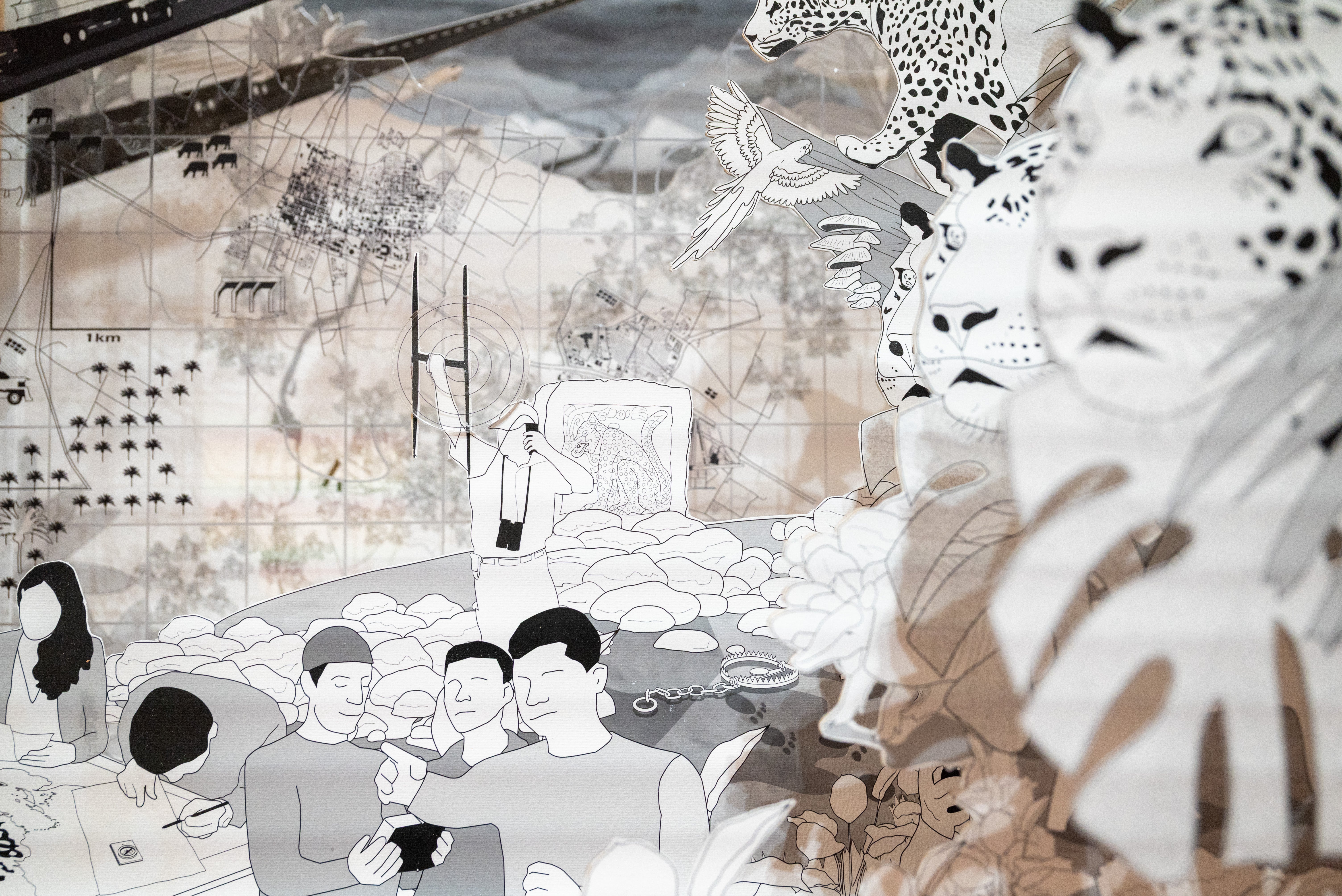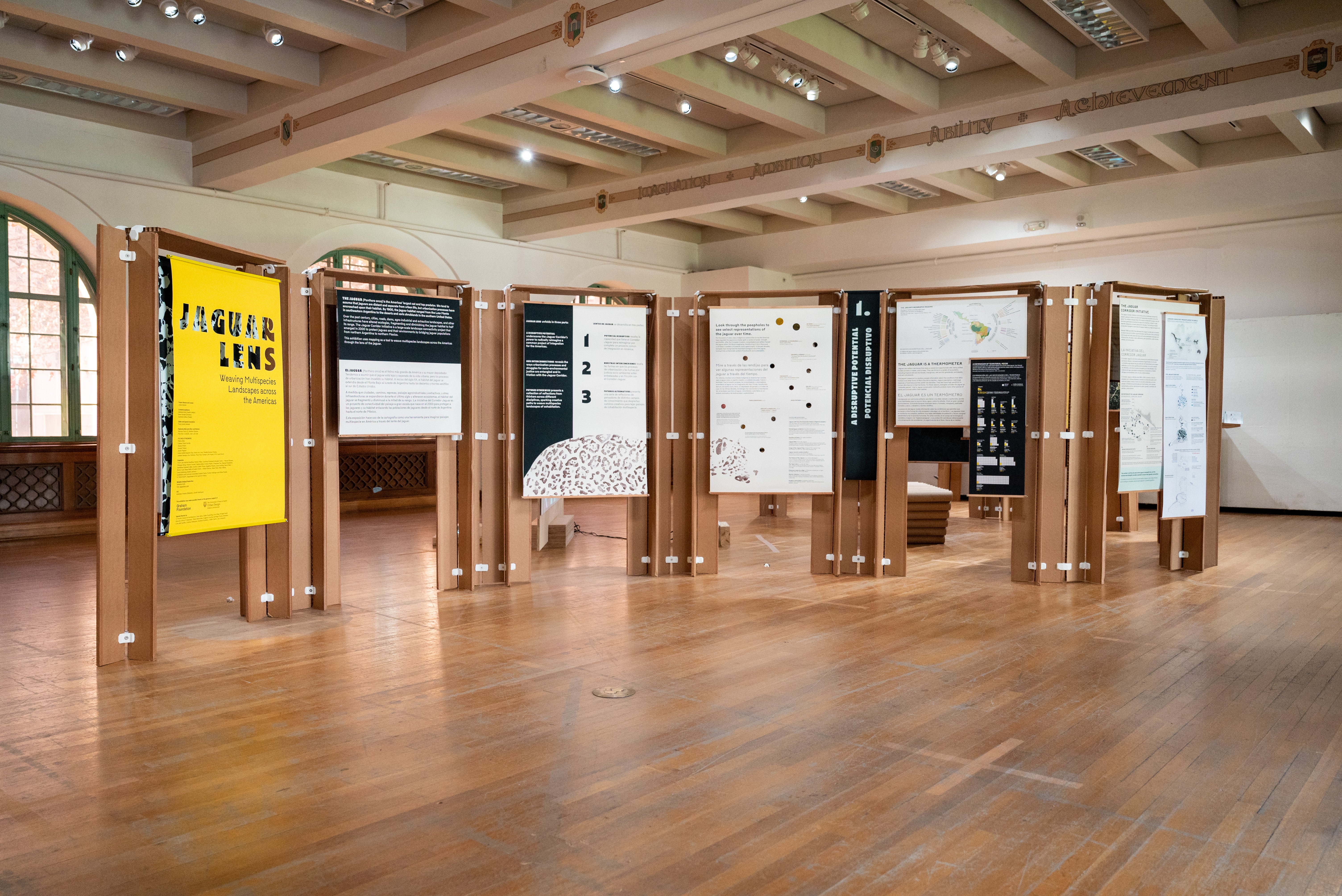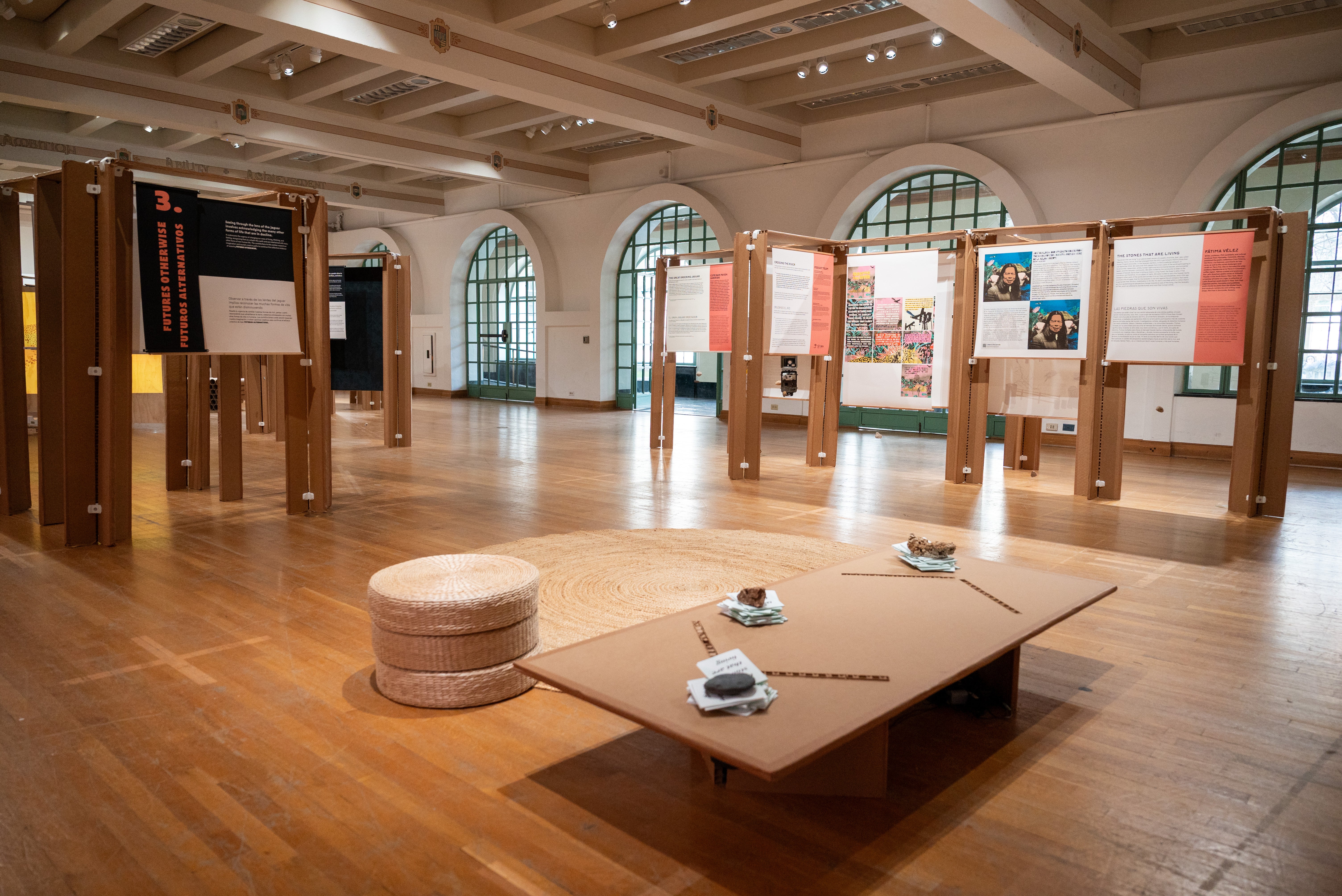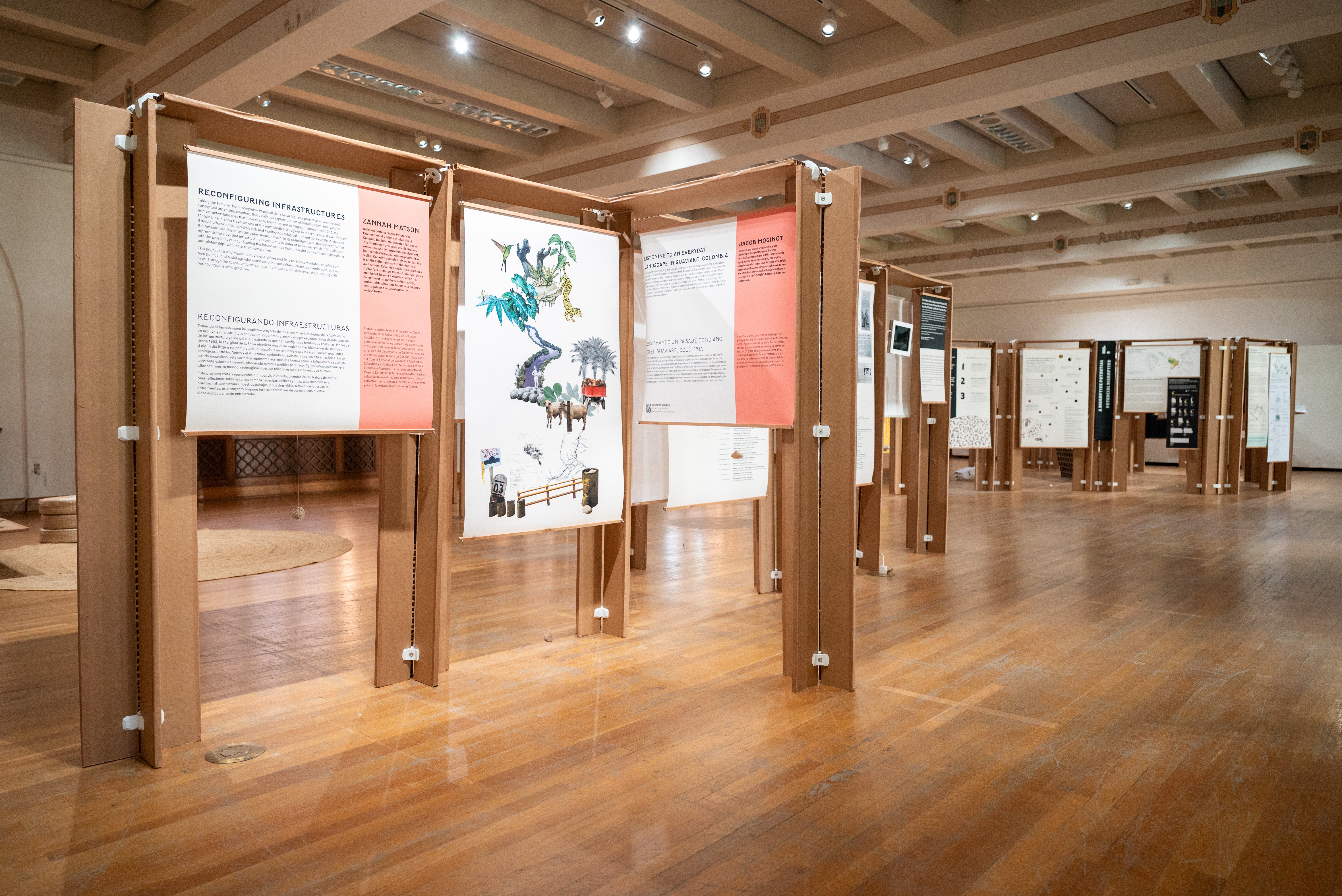Jaguar Lens: Weaving Multispecies Landscapes across the Americas
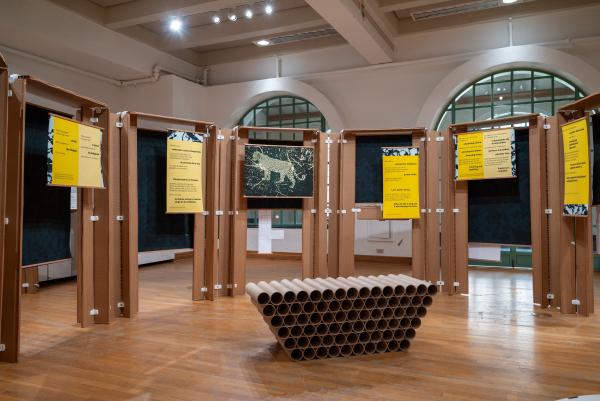
On view at the Mebane gallery in the School of Architecture, “Jaguar Lens: Weaving Multispecies Landscapes across the Americas” challenges viewers to adopt a multispecies perspective when studying the history of urbanization in the Americas.
“Jaguar Lens: Weaving Multispecies Landscapes across the Americas” invites spatial researchers and practitioners to move away from a city-centric view of the urban experience by adopting the lens of the jaguar, the largest feline and top terrestrial predator of the Americas. Combining a series of large-scale printed maps, interactive digital maps, and visual narratives, the exhibition will offer a view of the ways urbanization processes and socio-environmental struggles are entangled and in friction with the Jaguar Corridor — an unprecedented landscape integration project that envisions a continuous territory from northern Argentina to the southern United States to ensure the survival of the species. This exhibition is funded by the UT School of Architecture's Urban Design Program and by the Graham Foundation, which also awarded Salcedo a 2020 research grant to explore how the Jaguar Corridor can be interpreted as an infrastructure of care for the sustenance of human and nonhuman life.
We connected with organizer and Assistant Professor of Practice Juana Salcedo to learn more about her curatorial process and intentions with the exhibition.
Describe your interest in centering the perspective of the jaguar and how this often-mythologized apex predator offers an empowering lens to study today’s environmental crises.
Two different and converging paths moved me towards this research. One is my son, Emilio, who has been deeply fascinated and concerned about wildlife since his early years. His passion sparked my curiosity about other forms of life. On the other hand, I have had a longstanding interest in understanding urban life and the changing role that expanded spatial practitioners, architects, urban designers, and planners have played in shaping urban Latin America. In particular, I was interested in exploring how we can nourish generous forms of living together beyond the damaging anthropocentric and western-centric views that are increasingly making life unlivable. I soon found out that the jaguar, the largest feline and top predator of the Americas, was the node connecting these two interests.
Apart from being a fascinating animal with the ability to thrive in a wide variety of ecosystems, the jaguar has also held deep meanings for many Indigenous communities throughout the Americas for thousands of years–as a master spirit, a symbol of power, strength, and fertility. In contrast, western thought has only fairly recently shown an interest in the jaguar. Because the jaguar needs large extents of land to live and has slow reproduction rates, biologists now recognize that the jaguar is an umbrella species: its presence is telling of the health of an ecosystem, of the presence of fauna and flora, of the quality of air and water. Acknowledging this symbiotic role of the jaguar brings us closer to connecting with holistic Indigenous knowledge, but there is still work to be done.
We imagine the jaguar as a charismatic and iconic species that lives a mostly solitary and elusive life in the last remnants of the Americas rainforests, distant and disconnected from urban life. This is problematic because it renders invisible how the life of the jaguar is deeply entangled with urbanization processes. Cities, roads, dams, agro-industrial and extractive landscapes and other infrastructures have altered ecologies, fragmenting and diminishing the jaguar habitat to half of the territory where it lived by 1900. In other words, even if the jaguar tends to avoid being near us humans, the life of the jaguar is deeply entangled with and endangered by urbanization processes.
Jaguar Lens makes two key contributions: one is explanatory and the other fosters new forms of imagination for the future. The first underscores that looking through the lens of the jaguar reveals how urban life extends beyond the realm of cities and is enmeshed with the socio-environmental crisis. The second is that the Jaguar Corridor offers us a creative path to imagine Futures Otherwise that allow us to navigate living in the era of sixth mass extinction and global warming.
Introduce us to the project of the Jaguar Corridor—when did this term come about and who defined it? How is this region a barometer for complex environmental questions?
The Jaguar Corridor Initiative is a large-scale landscape connectivity project that seeks to restore and reconnect fragmented ecosystems that connect jaguars across the Americas, from northern Argentina to northern Mexico through both well-preserved areas and human-dominated landscapes and infrastructures.
The initiative emerged in the face of the continuous decline of jaguar populations and after DNA analysis showed that all jaguars throughout the Americas are genetically connected (instead of eight separate subspecies, as had been the consensus of scientists for decades). This realization prompted conservation biologists to propose the creation of The Jaguar Corridor Initiative in 2000. Since 2006 it has been led by the non-profit wildcat conservation organization Panthera. In 2018, Panthera, the Wildlife Conservation Society, the Wildlife Conservation Fund, the United Nations and fourteen jaguar range countries, signed the Jaguar 2030 Conservation Roadmap for the Americas, an official agreement to implement the Corridor in thirty prioritized landscapes. Despite the growing conservation efforts, recent studies concluded that the habitat range of the jaguar continues to rapidly decline. In the past two decades, 25% of the 2000 current range of the jaguar was lost.
Given that the story of the jaguar is of the flourish or decline of life, the purpose of my project is to render visible how the corridor is entangled with urbanization processes and socio-environmental justice struggles of various marginalized communities that live in the corridor. I do so by using the spatial skills of design, in particular, mapping and visual narratives. I refer to this exercise as a ‘cartography of interconnection,’ as in the effort to bridge conservation biology and urbanism through the lens of the jaguar; I propose a multispecies understanding of urban life.
Through this research, I became convinced that the Jaguar Corridor exceeds the realm of conservation biology. The Jaguar Corridor is a deeply political and collective project that we must attend to, care about, and cultivate.
Linked to the research and this exhibition, I also created a website for open access to the interactive cartography and geospatial data: https://jaguarlens.com.
As touched upon in the exhibition, mapping and cartography have historically been tools for colonization and resource extraction. How did you critically approach these methods to communicate research findings?
Maps are instruments of power; they have enabled conquest, colonization, and dispossession. At the same time, maps are tools of dissent; they are powerful artifacts that can spark alternative ways of seeing and reimagining the world.
Jaguar Lens is a project of critical cartography that aims to activate the latter dimension, recognizing the creative potential of mapping. This means being careful with every decision and at every step, as we need to reflect on the map's disposition to see landscapes, nature, and peoples in specific ways, thus prompting new forms of imagination.
One example of this is the selection of cartographic projection. The commonly-used Mercator projection has a tendency to exaggerate the size of Europe or the US. Should the cartography of interconnection reproduce this projection? Furthermore, should I keep the map’s conventional orientation, with the north pointing upward, as if that was the natural direction? Or should we alter and destabilize these conventions?
Another key question is how to represent urban life. Usually, we think of urban life as the life within cities, that is, as a collection of dots in a map, as if urban life was limited to cities and as if cities were bounded territories. This approach creates a tunnel vision that leaves out the operational, agricultural, and extractive landscapes and infrastructures that are part of the processes of urbanization of colonial and industrial capitalism. It also occludes the many forms of human and other forms of life that are enmeshed, affected, and often subordinated in the quest of supporting urban life. So, how do you represent this extended reach?
For this reason, a key part of the project has been disinterring and correlating pertinent geospatial information to shed light on these interconnections. Throughout the research I found public geospatial data that identified socio-environmental transformations—such as degrees of land use changes, tree cover loss, and socio-environmental conflicts—provided a richer framework to represent the landscapes of the Jaguar Corridor.
Here, the cartography shows how even if the Jaguar Corridor is a stronghold against the processes of urbanization, the corridor also overlaps with over 240 cities and towns and it is a deeply contested territory. It is a territory conceived by many companies and governments as a frontier of extraction and waste disposal but is also a living landscape where many Indigenous communities, peasants, and other marginalized populations have struggled and continue to struggle for environmental justice and their right to live in these territories.
Finally, in the exhibition space, the question was how to foster a deeper affect, recognizing that maps are still abstract and detached ways of seeing. That led us to create a physical model where we project a video that weaves together aerial views, photographs, and voices, revealing how commodity extraction produces ecological devastation and polluted landscapes. In addition, we conveyed more of a visual narrative through a habitat diorama developed by Brent Ryndak, a 2023 graduate from the Landscape Architecture program. In contrast to how natural history museums use it to stage wildlife in idealized pristine natures, this diorama proposes to reconnect the jaguar with the urban experience.
This exhibition is built of deceivingly simple construction of paper, wood, and interlocked cardboard—could you tell us the story of the materials used for the display structures and what atmosphere you hoped to create?
The design of the exhibition resulted from two considerations: that the exhibition could eventually travel to other venues, the creation of a bilingual narrative space that fits well within the Mebane Gallery.
I concluded that designing a traveling exhibition meant that it needed to be flexible enough to adapt to different spaces as well as lightweight and fairly easy to assemble. I encountered a modular system of plastic connectors made in Italy called Playwood, which is usually used for DIY furniture. I decided to use the honeycomb cardboard sheets because they are very lightweight and fairly easy to find and cut. Rather than working with large surfaces which are harder to move, I used the sheets to assemble thin columns with wood hanging frames to hang the exhibition material. I was mostly interested in relying on more paper-based material instead of rigid pvc or plastic banners for the boards, and that is why we ended up deciding on using mostly watercolor paper; which adds a lot of texture. I used little stones from my rock collection as weights to stretch a bit the natural bend of the paper when needed.
On the other hand, the question of how to make a narrative space shaped the way the exhibition is arranged. I wanted to encourage a folding path that moved us from a general to a more situated and affective understanding of the Jaguar Corridor, walking the audience through the first two sections. The first section moves us through the reasons why the Jaguar Corridor has the potential to reimagine a common project of interspecies integration for the Americas. The second section offers an immersion into the interconnections, revealing how the corridor is entangled with urbanization processes and with the socio-environmental justice struggles of various marginalized communities. From that path, the space opens towards the final section of the exhibition: “Futures Otherwise.” This section presents a collection of reflections from thinkers across different disciplines about multispecies living. Here, the flexibility of the system allowed me to arrange, expand and contract it according to the needs of each contributor, giving each the space it needed.
Can you share more about the collaborations and contributions in this exhibition?
Far from a solitary endeavor, the making of this exhibition was a deeply collective and collaborative process.
The exhibition team included Brent Ryndak and Adelaida Avila who led the Graphic Design of both the exhibition and the website. Together, the three of us bounced back and forth the ideas that shaped the narrative of the exhibition but I also benefited from the conversations and feedback with many friends and colleagues. Also, Sushmita Sidhar, a first year UT Master of Urban Design student, was in charge of the model of the Americas. Maria Camila Salcedo was editor and oversaw the Spanish translation. In addition, the exhibition was developed with the amazing support of the staff and students from the SOA Build Lab and the Tech Lab.
Another key part of the exhibition was inviting other voices to instigate broader conversations. The exhibition includes a piece from the photo montage series, “Natureza Morta” by the wonderful artist Denilson Baniwa, who is of Amazonian origin from the Baniwa nation in Brazil. It also includes a stop motion animation titled “More than a Catwalk” made by Colombian artist and anthropologist Jose Luis Cote, which he specifically made for the exhibition.
For the “Futures Otherwise” section, there are five contributions:
A reflection from Esteban Payán, a biologist and pioneering jaguar expert who led the Jaguar Corridor Initiative in both Colombia and South America for over a decade. Esteban, who pioneered the use of camera traps in Colombia, sent one of the first cameras he used in the Amazon and he also shares excerpts from his field work diaries which convey much more than scientific data.
A presentation of the fantastic podcast series Crossing the River that is being produced as part of NYU Law School’s More Than Human Life (MOTH) Project where we hear indigenous leaders from across the world. We included, in particular, the conversation with Sarayaku leader Jose Gualinga and the Sarayaku people’s proposal towards the recognition of the rights of nature through the concept of the Kawsach Sacha, the Living Forest.
Connected to this contribution, the exhibition has a sitting area where you can read ‘the stones that are living’, a poetic chronicle written by Colombian poet Fátima Vález based on an encounter organized last year in the Sarayaku territory by MOTH. This poem was printed in the School of Art by an incredible group of undergraduates who lead the UT Riso room so everyone can take it home.
The “Futures Otherwise” section also includes a collaborative contribution: Zannah Matson’s reflections on the ravages of the infrastructural interventions and colonization processes that transformed the Amazonian piedmont in Colombia, along with a soundscape that records the everyday landscape of this area produced by scientist and sound artist Jacob Monigot as he joined Zannah during one of her field trips.
Finally, you will find Brazilian architect and visual artist Silvana Olivieri’s moving and fabulous story of Peteleca, a young female cougar who escaped from captivity in the Brazilian city of Salvador during the 1970s. Olivieri retraces the city’s emotional rollercoaster during the two months that the cougar was loose in the city, awakening fear but also celebrations of freedom and redemption. Forty years later, Silvana decides to return to the waters of the San Francisco river in the Caatinga, where Peteleca was born and snatched from.
As an organizer of the upcoming The Urban Entanglements Conference (March 26-28), what takeaways do you hope attendees will leave with? How do you foresee study of Latin American ecological equity shaping global environmental conversations?
The 2025 Lozano Long Conference entitled Urban Entanglements: Centering Marginalized Lives and Ecologies in Latin America that I am co-organizing with assistant professor of History Santiago Muñoz will gather an amazing group of speakers from various disciplines. The conference will feature two keynote lectures, three panels, and one roundtable that aim to expand our understanding of the urban experience in Latin America from 1400 to the present.
Latin America is a fascinating region that initiates pivotal global change. In recent years, scholars have identified the invasion of the Americas is a breaking point that stirs what they have termed the Anthropocene. Borrowing from the Feral Atlas, this is a long period in which the “colonial and industrial remakings of the earth [that] have created the dangerous environmental conditions that confront us today.” Attendees will have the opportunity to learn from new branches of scholarship that are exploring cities in relation to the wider territories and ecologies they depend on, recentering the lives of marginalized human and more-than-human actors, and developing non-conventional narratives that nourish a broader conception of the urban experience. In doing so, we aim to discuss the challenges and potentials of forging other possible futures for life on our warming planet.
Featured Contributors:
Denilson Baniwa
José Luis Cote
Carlos Andrés Baquero-Díaz, Goldy Ann Levy, Natalia Arenas Chaves, Johana Navajas, a.k.a Nefazta, More Than Human Life Project (MOTH), NYU Law School
Fátima Vélez
Zannah Matson
Jacob Moginot
Silvana Olivieri
Esteban Payán Garrido
Exhibition Team:
Adelaida Ávila
Brent Ryndak
Sushmita Sridhar
Maria Camila Salcedo
